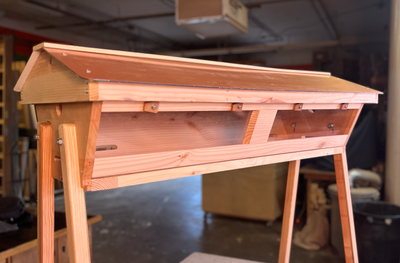Spring Feeding
Early spring can be a wobbly time for bees and a tense time for hobby beekeepers.
Established colonies can run out of honey stores or be struggling against protracted, inclement weather. Forage could be slow to bloom and package bees might not be able to immediately start gathering nectar and pollen.
If you have packaged bees lined up to install in a new hive come spring, you will want to understand spring feeding to help establish the colony.
When Do I Feed?
It depends on several things. First, your geography. Is the daytime temperature where you are consistently above 45-50 degrees and is there available forage? To begin establishing the colony and drawing comb, bees will need forage on the earliest blooming spring plants in your area.
Here in Portland, Oregon we often see a span of a few weeks between when package bees arrive and when solid forage is available. And of course, sustained rains can prevent or stall foraging. Due to this, we often have to feed for the first few weeks that a package is getting established.
Once we see dandelions bloom (not the earliest spring forage, but one that signifies the season is in full swing; consider what the first prolific forage is in your area), we generally pull feeders, as long as the forecast looks cooperative, and we are seeing healthy signs like a steady or growing colony population and good wax building. Forage is always better for bees than feeding! It’s what they are built to do, after all!
What Should I Feed Them?
In Spring months - March | April | May
The best feed would be honey from your other hives or honey from a reputable, local beekeeper. Honey is always the best feed for bees! It’s the healthiest and most natural, of course.
If you do not have a source of local, raw honey,
you can feed a simple syrup solution.
Spring feed is a liquid 1:1 ratio of simple syrup
(1 cup cane sugar to 1 cup water).
Making the syrup:
Heat your water below a boil. (Don’t boil the syrup! You just want to make a simple solution). Add the sugar and stir until dissolved. Once all of the sugar is dissolved with none remaining on the bottom, let cool to room temperature and then feed.
Which Feeder Should I Use?
This also depends… on your hive type!
Langstroth hive
Place your inner cover over the topmost box that your bees are occupying. Set a jar feeder over the hole in the inner cover, and surround it with an empty box followed by your outer cover. Alternatively, you can use an entrance feeder if you have one by sliding it into the entrance of your hive. While entrance feeders work, they sometimes lead to robbing, so we do recommend top feeders.
Note: While you can use any of our feeder types for a 10-frame Langstroth, the gallon hive top feeder is too wide for an 8-frame hive!
Warre hive
For Warre hives, you can use a double jar feeder or a round hive top feeder. First, cut a flap in your separator canvas the size of your feeder. Put it back in place on your top bars and fold the flap back. Place the feeder over the cut-out you made. Enclose the feeder with an empty hive box, and put your quilt box and roof back in place.
Top Bar hive
Using a double jar feeder or round top feeder, place the feeder in the empty portion of your hive, beyond the divider board. You can prop the divider board up with sticks so the bees can pass under to access the feeder or drill cork-sized holes in the bottom for your bees to crawl through. Place the feeder in the bottom of the empty cavity and place empty top bars back on top.
(A round top feeder works, but the feeder will have to be propped up on sticks or makeshift stilts to fit in the hive cavity, as the hive cavity at the bottom is 10” and the feeder diameter is 10.5”.)
How to Avoid Feeding Next Year
It’s always ideal for bees to be eating their own honey stores; after all, their entire purpose of existence is to use all of the honey they have made to make it through winter! Pollination for us and providing us with honey -- those are just wonderful side benefits.
We always instruct that beekeepers leave all of the honey in the colony’s first year.





